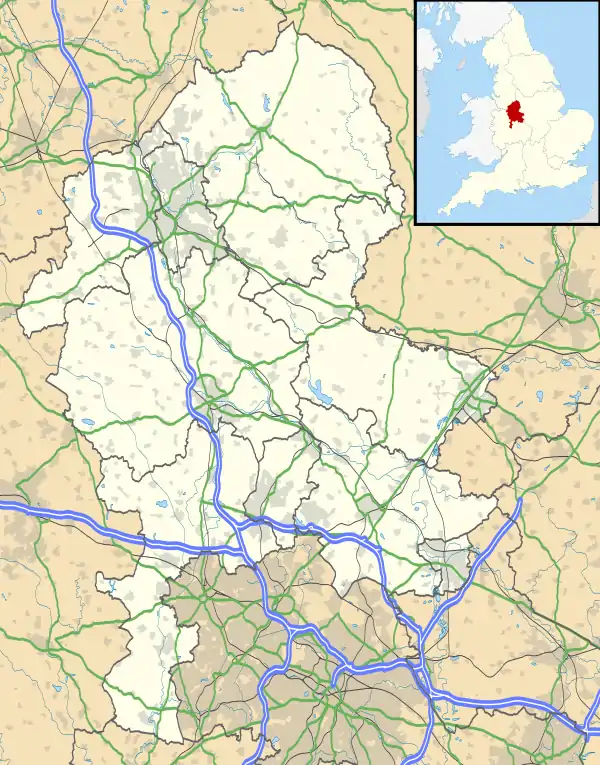County Buildings, Stafford
County Buildings is a municipal facility at Martin Street in Stafford, Staffordshire. The building, which is the meeting place for Staffordshire County Council, is a Grade II* listed building.[1]
| County Buildings, Stafford | |
|---|---|
 The Martin Street frontage in 2015 | |
| Location | Stafford, Staffordshire |
| Coordinates | 52.8069°N 2.1161°W |
| Built | 1895 |
| Architect | Henry Hare |
| Architectural style(s) | Baroque revival style |
Listed Building – Grade II* | |
| Designated | 17 December 1971 |
| Reference no. | 1298178 |
 Location of County Buildings, Stafford in Staffordshire | |
History
In the 19th century the Shire Hall in Market Square became well established as the venue for judicial meetings and civic functions in the county.[2] Following the implementation of the Local Government Act 1888, which established county councils in every county, there was a need to find offices and a meeting place for Staffordshire County Council.[3] Council leaders decided to procure new county offices: the site they selected in Martin Street had previously been occupied by several a row of retail properties.[4]
The new County Buildings, which were designed by Henry Hare in the Baroque revival style, were completed in 1895.[5][6] The design involved an asymmetrical main frontage with fifteen bays facing onto the Martin Street; the central section of seven bays featured a doorway with an architrave and segmental pediment with mullioned windows on the first floor.[1] The left hand section, which slightly projected forward, featured a window split by Ionic order columns while the right hand section, which also slightly projected forward, featured a venetian window.[1] Internally, the principal room was the council chamber which featured plasterwork by Frederick Schenck as well as figures sculpted by William Aumonier.[1]
In April 2009 the council announced plans for a new headquarters in Tipping Street: the new offices were designed by 3DReid, built by Volker Fitzpatrick at a cost of £38 million and completed in October 2011.[7][8][9] The new offices were officially opened by the Countess of Wessex as "Staffordshire Place" in May 2013.[10]
Following the departure of council officers and their departments to Staffordshire Place, much of the office space in County Buildings was converted into a series of private residences known as "Martin Street Mansions".[11] However, the county council retained the main civic rooms and continued to hold full meetings of the county council in the council chamber.[12] The civic rooms in County Buildings were also made available for weddings and civil partnerships.[13]
See also
References
- Historic England. "County Buildings and Judges House, Stafford (1298178)". National Heritage List for England. Retrieved 23 August 2019.
- Historic England. "Shire Hall and Attached Railings, Gates and Lamp Standards, Stafford (1298177)". National Heritage List for England. Retrieved 23 August 2019.
- "Local Government Act 1888". Legislation.gov.uk. Retrieved 17 August 2019.
- "Ordnance Survey Map". 1881. Retrieved 25 October 2020.
- "County Buildings". Staffordshire County Council. Retrieved 23 August 2019.
- Pevsner, Nikolaus (1974). Staffordshire. The Buildings of England. Harmondsworth: Penguin Books. p. 244. ISBN 0-14-071046-9.
- "Staffordshire County Council HQ". E-Architect. 14 April 2009. Retrieved 25 October 2020.
- "Wraps off £38m Staffordshire County Council HQ". Express and Star. 21 December 2011. Retrieved 23 August 2019.
- "Builders of council headquarters face compensation claim". BBC. 20 June 2012. Retrieved 14 November 2020.
- "Men at work again after duchess officially opens beleaguered council HQ". Express and Star. 12 May 2013. Retrieved 14 November 2020.
- Oakley, Tom. "Martin Street Mansions: See the ex-council offices turned into luxury apartments". Express and Star. Retrieved 14 November 2020.
- "Agenda and draft minutes". Staffordshire County Council. 25 July 2019. Retrieved 23 August 2019.
- "County Buildings". Staffordshire Wedding. Retrieved 25 October 2020.